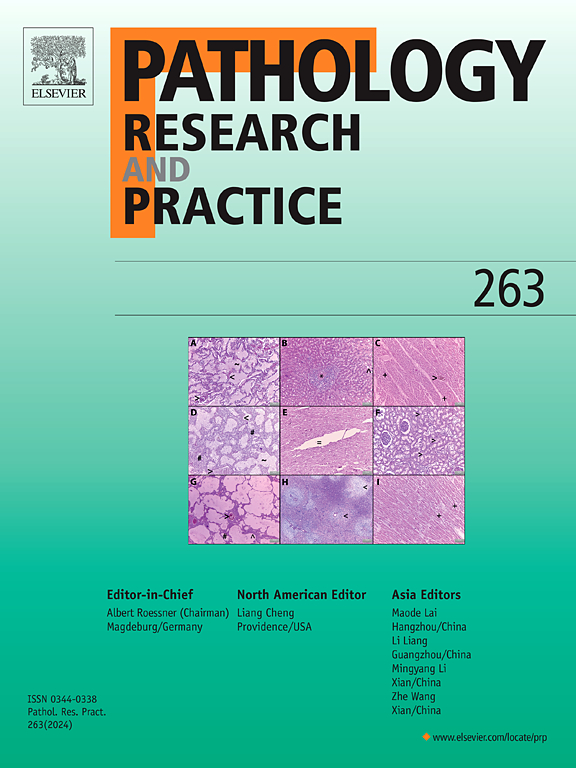肾细胞癌合并ALK- tpm3基因融合及ALK扩增1例并文献复习。
IF 2.9
4区 医学
Q2 PATHOLOGY
引用次数: 0
摘要
背景:间变性淋巴瘤激酶(ALK)-重排肾细胞癌(ALK- rcc)是一种罕见的由分子定义的肿瘤实体,被列入世界卫生组织肿瘤分类第五版。其特点是ALK基因与各种融合伙伴基因重排,最常见的结果是致癌融合蛋白导致ALK活化。病例介绍:一名30岁的中国男性因左肾肿瘤(直径5 cm)行部分肾切除术。组织学上,肿瘤呈多形性,排列为乳头状、管状和实状。高倍镜下可见丰富的嗜酸性细胞质、明显的细胞质空泡化和细胞核移位。免疫组化显示PAX8、CK7、CAIX和ALK(D5F3)弥漫性阳性。荧光原位杂交(FISH)显示肿瘤细胞中ALK扩增和分裂。下一代测序检测ALK- tpm3基因融合和ALK扩增。结论:我们报道了首例ALK- rcc同时扩增和融合的病例。本文介绍该病例的临床资料、形态学、免疫组织化学和分子特征,旨在提高临床医生和病理学家对ALK-RCC的临床和病理认识。本文章由计算机程序翻译,如有差异,请以英文原文为准。
Renal cell carcinoma with ALK-TPM3 gene fusion and ALK amplification: A case report and literature review
Background
Anaplastic lymphoma kinase (ALK)–rearranged renal cell carcinoma (ALK-RCC) is a rare molecularly defined tumor entity included in the fifth edition of the World Health Organization Classification of Tumors. It is characterized by rearrangement of the ALK gene with various fusion partner genes, which most commonly results in oncogenic fusion proteins leading to ALK activation.
Case Presentation
A 30-year-old Chinese man underwent partial nephrectomy for a left renal tumor measuring 5 cm in diameter. Histologically, the tumor is pleomorphic and arranged in papillary, tubular, and solid patterns. At high magnification, abundant eosinophilic cytoplasm, obvious cytoplasmic vacuolation, and displaced nuclei were observed. Immunohistochemistry revealed diffuse positivity for PAX8,CK7,CAIX, and ALK(D5F3). Fluorescence in situ hybridization (FISH) showed ALK amplification and break-apart in tumor cells. ALK-TPM3 gene fusion and ALK amplification were detected by next-generation sequencing.
Conclusion
We report the first case of ALK-RCC with concurrent ALK amplification and fusion. This article presents the clinical data, morphology, immunohistochemistry, and molecular characteristics of this case, with the aim of enhancing the clinical and pathological understanding of ALK-RCC among clinicians and pathologists.
求助全文
通过发布文献求助,成功后即可免费获取论文全文。
去求助
来源期刊
CiteScore
5.00
自引率
3.60%
发文量
405
审稿时长
24 days
期刊介绍:
Pathology, Research and Practice provides accessible coverage of the most recent developments across the entire field of pathology: Reviews focus on recent progress in pathology, while Comments look at interesting current problems and at hypotheses for future developments in pathology. Original Papers present novel findings on all aspects of general, anatomic and molecular pathology. Rapid Communications inform readers on preliminary findings that may be relevant for further studies and need to be communicated quickly. Teaching Cases look at new aspects or special diagnostic problems of diseases and at case reports relevant for the pathologist''s practice.

 求助内容:
求助内容: 应助结果提醒方式:
应助结果提醒方式:


